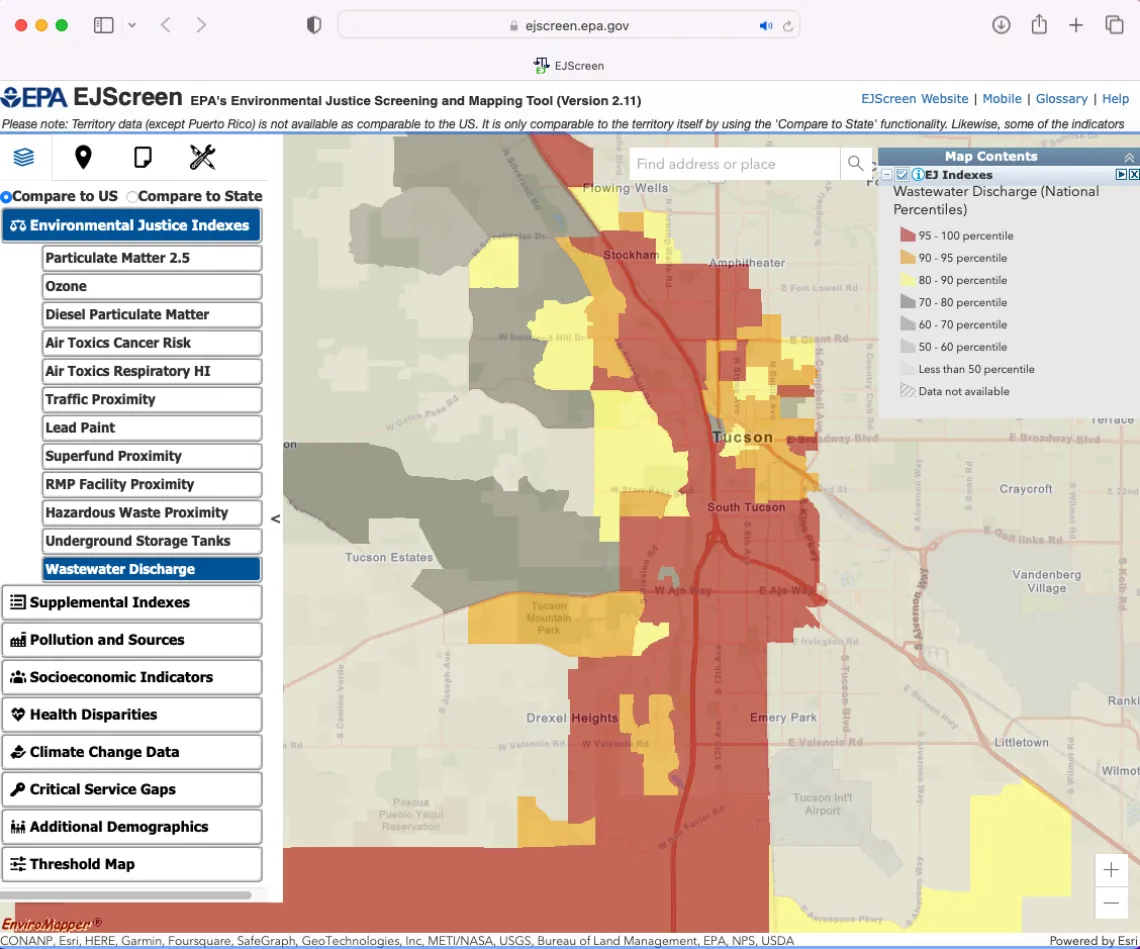Udall Center Researcher Appointed to EPA Science Advisory Board Environmental Justice Screen Review Panel
In her first appointment with a federal agency since becoming a U.S. citizen, Adriana Zuniga-Teran will help evaluate and provide feedback on the EPA’s online EJScreen tool.

The EJIScreen tool shows environmental impacts across the U.S. at the census block level. Shown here is a map of wastewater discharge around metro Tucson.
Udall Center Assistant Professor of Environmental Policy Programs Adriana Zuniga-Teran was recently appointed to serve on the U.S. Environmental Protection Agency (EPA) Science Advisory Board (SAB) Environmental Justice (EJ) Screen Review Panel.
The panel has been tasked with evaluating the EPA’s newly updated EJScreen, an environmental justice screening and mapping tool that allows users to look at and compare environmental impact data for communities across the United States at the census-block level.
Production on the EJScreen began in 2010. An initial round of expert review on the tool took place in 2013 before it was made available to the public in 2015.
The online tool offers the ability to examine the effects of 12 environmental indicators including particulate matter in the air, prevalence of lead paint in an area, and proximity to hazardous waste, and to overlay that data with seven socioeconomic indicators such as race, income, unemployment rate, and average level of education in a given area.
The 19-person review panel is made up of nationally and internationally recognized scientists with demonstrated expertise in various fields including applications of geographic information science, index development, modeling and “demonstrated experience working with overburdened and vulnerable communities, or communities with EJ concerns,” according to a press release on the subject from the EPA.
Zuniga-Teran is the only representative on the review panel from the University of Arizona. She was nominated to participate by past Udall Center Director and current Research Professor Bob Varady and was selected for her expertise in urban planning and design, green infrastructure, water security and environmental justice.
Scope of the Work
After a basic introductory meeting of the panel in mid-March, the SAB EJScreen Review Panel convened for a four-hour virtual meeting during which they were trained on how to use the EPA’s EJ tool and walked through a series of Charge Questions outlining the scope of their review.
Panelists will be looking at six criteria to evaluate the efficacy and accuracy of the EJScreen tool, including the logic of the calculations and algorithms operating behind the scenes, the technical accuracy of the data and the methodology for compiling that data. Zuniga-Teran was tasked specifically with looking at the tool’s consideration of rural geographies.
Following the initial instructional meeting, panelists will have until April 21 to provide feedback on their assigned Charge Questions. They will then convene in person in Washington, D.C. on May 8-10 to discuss their findings. A final report will be drafted in June before it is reviewed by the panel of experts and ultimately submitted to the EPA.
Long Road, “Humbling” Experience
For Zuniga-Teran, appointment on the review panel marks her first time being invited to participate on a federal review board since becoming a United States citizen in November 2022.
“It’s such a great honor for me,” says Zuniga-Teran, who immigrated to the United States from Monterey, Mexico in 2007 to pursue a Master’s Degree in Architecture at the University of Arizona. “It feels like recognition of my scholarship in an area that I publish in and care a great deal about and it’s humbling to be recognized at this level,” she says.
As a practicing professor in the UArizona School of Geography, Development and Environment, Zuniga-Teran is excited about the possibility of using the EJScreen in her classes. “For my work, it’s really useful because I teach environmental justice,” she says, adding that she was “thrilled” to learn how to use the tool so that she can build class activities around the EJScreen.
Of course, she says, the EJScreen isn’t a panacea for addressing the nation’s EJ woes. The website for the tool is explicit in its declaration that it is not meant to be used to “provide a risk assessment.” The website also states that data represented on the EJScreen becomes less reliable as users zoom in to examine a specific area and that some data used therein may occasionally fall out of date.
Zuniga-Teran says she is grateful and excited to know that the federal government is taking concerns about EJ seriously in the face of climate change. “It’s a very big step in the right direction of raising awareness of this issue,” says Zuniga-Teran. “Some people are more impacted by environmental justice issues than others and that message is very clear.”
As reported in December 2022, the Centers for Disease Control and Prevention (CDC) has also developed its own online EJ Index tool. U.S. Assistant Secretary of Health Admiral Rachel Levine traveled to UArizona at that time to offer a training on how to use the CDC’s Environmental Justice Index.

